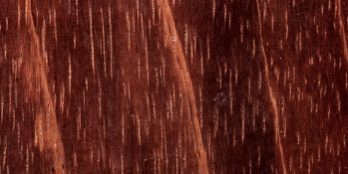Rengas Wood: Features and Applications
Introduction
Rengas wood, derived from Gluta spp. and Melanochyla spp., is known for its striking dark red-brown or deep blood-red heartwood with black streaks. It is a prized cabinet wood in Malaysia, commonly referred to as rengas with various epithets across the region.
Key Characteristics
-
Density: Medium Hardwood with a density of 640-960 kg/m³ (air-dry).
-
Durability: Moderately durable, susceptible to termite attacks.
-
Texture: Moderately coarse to fine, with interlocked grain.
-
Strength: Classified in Strength Group B (SG4)—strong and suitable for medium construction.
-
Machining: Slightly difficult to work with; surfaces can be moderately smooth to rough depending on the process.
Applications
Rengas wood is ideal for:
-
Cabinetry and Furniture: Valued for its unique red streaks and rich color.
-
Decorative Uses: Suitable for panelling, mouldings, and picture frames.
-
Structural Uses: Can be used for beams, posts, rafters, and railway sleepers.
-
Ornamental: Great for tool handles, walking sticks, and ornamental pieces.
Note: While the sap is poisonous in fresh timber, seasoned wood is safe to handle.
Handling and Drying
-
Nailing: Excellent nailing properties.
-
Air Drying: Moderate drying time—13mm boards dry in 2 months, 38mm boards in 5 months.
-
Shrinkage: Low shrinkage, making it stable for use.
INTRODUCTION
The Standard Malaysian Name for the timber of Gluta spp. and Melanochyla spp. (Anacardiaceae). Vernacular names applied are usually rengas (Peninsular Malaysia, Sabah and Sarawak) with various epithets. The major species contributing to the timber include Gluta aptera, G. elegans, G. malayana, G. renghas, G. torquata, G. wallichii, G. wrayi; Melanochyla auriculata, M. bracteata, M. caesia and M. fulvinervis. The sapwood is light pink-brown or light brown and is sharply differentiated from the heartwood, which is dark red-brown or deep blood-red, with bands of darker, almost black streaks.
Also known as Rengas (Brunei); Kroeul (Cambodia); Gluta (India); Anga, Poei and Rengas (Indonesia); Mai nam kiang (Laos); Burma Gluta, Chay, Thayet-thitsi and Thitsi (Myanmar); Hekakoro (Papua New Guinea); Lingas (Philippines); and Rak and Rak-ban (Thailand).
DENSITY
The timber is a Medium Hardwood with a density of 640-960 kg/m3 air dry.
NATURAL DURABILITY
The timber is moderately durable, being susceptible to termite attacks.
PRESERVATIVE TREATMENT
The heartwood is extremely difficult to treat with preservatives, while the sapwood is amenable.
TEXTURE
Texture is moderately coarse to fairly fine and even, with interlocked or occasionally straight grain.
STRENGTH PROPERTIES
The timber falls into Strength Group B (Engku, 1988b) or SG4 (MS 544: Part 2: 2001).
Strength Properties of Rengas (G. torquata)
Test Condition |
Modulus of Elasticity(MPa) |
Modulus of Rupture(MPa) |
Compression parallel to grain (MPa) |
Compression perpendicular to grain (MPa) |
Shear Strength (MPa) |
Green |
14,000 |
81 |
41.4 |
5.31 |
10.6 |
Air dry |
14,900 |
111 |
59.4 |
7.65 |
13.2 |
MACHINING PROPERTIES
It is slightly difficult to resaw and cross cut and the planed surface is only moderately smooth.
Machining Properties of Rengas (G. torquata)
Test condition |
Sawing |
Planing |
Boring |
Turning |
||||
Rip-sawing |
Cross- cutting |
Ease of planing |
Quality of finish |
Ease of boring |
Quality of finish |
Ease of turning |
Quality of finish |
|
Green |
easy to slightly difficult |
easy |
easy |
moderately smooth |
slightly difficult |
slightly rough |
– |
– |
Air dry |
slightly difficult |
slightly difficult |
difficult |
moderately smooth |
slightly difficult |
slightly rough |
slightly difficult |
rough |
NAILING PROPERTY
The nailing property is rated as excellent.
AIR DRYING
The timber seasons moderately slowly, with slight twisting and insect attacks as the main sources of degrade. 13 mm thick boards take approximately 2 months to air dry, while 38 mm thick boards take 5 months.
KILN-DRYING
Kiln Schedule E is recommended.
Kiln Schedule E
Moisture Content (%) |
Temperature
|
Temperature (Wet Bulb) |
Relative Humidity (%) |
||
� F |
� C |
� F |
� C |
||
Green |
120 |
48.5 |
115 |
46.0 |
85 |
60 |
120 |
48.5 |
113 |
45.0 |
80 |
40 |
125 |
51.5 |
116 |
46.5 |
75 |
30 |
130 |
54.5 |
117 |
47.0 |
65 |
25 |
140 |
60.0 |
120 |
49.0 |
55 |
20 |
155 |
68.0 |
127 |
53.0 |
45 |
15 |
170 |
76.5 |
136 |
58.0 |
40 |






